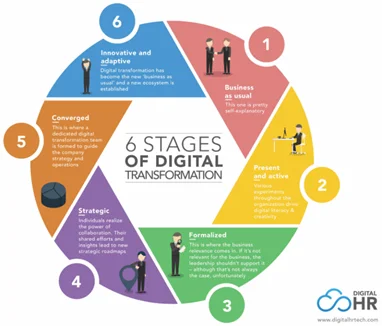HR Digital Transformation – A Business State of Mind (Part 1 of 6)
The unspoken conclusion in both statements is that the technology itself is driving the evolution of the definition of Digital Transformation. What is possible technologically is constantly expanding, which in turn is impacting its application to drive new HR paradigms and constantly refine the definition.
"Digital Transformation is not an end state, but a "state of mind"."
- Business as usual - This one is self-explanatory.
- Present and active - Various experiments throughout the organization drive digital literacy & creativity.
- Formalized - This is where the business relevance comes in. If it's not relevant for the business, the leadership shouldn't support it – unfortunately, that's not always the case.
- Strategic - Individuals realize the power of collaboration. Their shared efforts and insights lead to new strategic roadmaps.
- Converged - This is where a dedicated digital transformation team is formed to guide the company strategy and operations.
- Innovative and adaptive - Digital transformation has become the new 'business as usual' and a new ecosystem is established.

Summary
The important takeaway is to understand that while it is impossible to determine the exact moment when an organization achieves HR Digital Transformation and what that looks like, a path can still be charted. Without a concept of the destination, the journey cannot begin (or as paraphrased from Casey Stengel, "If a person does not know where they are going, they will likely end up somewhere else!").
As certain technological milestones are achieved, the characteristics of the 6 stages of Digital Transformation will be evident because previously defined business goals will also have been achieved. In my opinion, one of the key attributes evident of Stage Six is the ability to "Thinking Digitally" (the instinctive approach of thinking about how automation can improve efficiency and effectiveness). However, I will also add that an organization does not have to achieve Stage Six to Think Digitally about how to address issues.
"Thinking Digitally" (the instinctive approach of thinking about how automation can improve efficiency and effectiveness)."
This is the first in a 6-part series where I discuss the topic of HR Digital Transformation from, hopefully a somewhat new perspective.
I look forward to your comments and extensions of this discussion. I am sure I will learn something from the feedback.
About Author
Steve Bradley is Former VP and Director for the Cloud HCM Practice at Birlasoft. He has over 20 years of HCM technology experience – and founder of two HR service companies, SystemLink and Learn2Perform. He is a frequent speaker at conference events and advisor to organizations of all sizes on the topic of HR Digital Transformation, HCM Technology and HR Organizational Change in a technology age.
